CHAPTER 1
Illumination
Illumination is the key to growing any houseplant successfully. Light in any form, be it natural or electric, is the sustenance for your plants. The only time they “eat” is when light is falling on their leaves. When a plant takes in light, water, and carbon dioxide, it converts it to food for itself. This process takes place in the green, chlorophyll-filled cells of the plant and is called photosynthesis. The best part for you, me, and all life on earth is that the byproduct of photosynthesis is oxygen. If it weren’t for plants, life on earth as we know it would not exist.

SUNLIGHT
Let’s first talk about the light everyone has streaming into the windows of their homes: sunlight.
SOME HOMES RECEIVE more light than others—this depends on the style of home and the number of windows it has.
If light is the key to plant health, how do you know whether you have enough to sustain plant life? If there is enough light in your room to read a book, you have enough to sustain a low-light plant. You may have more light than you realize and can grow a large variety of plants. Initially, you need to determine the amount of light in your home and from which direction it originates. It is important to know whether your windows face east, west, north, or south. Most homes and large apartments have windows facing multiple exposures. If, however, you live in a small apartment, you may have windows that face only one direction.
If you aren’t compass-savvy, it’s easy to determine an east- or west-facing window based on whether you notice if the sun rises or sets in it, respectively. If you never notice any direct sun at all, you probably have a northern exposure. On the other hand, if the sun shines in your window all afternoon, your window faces south.
Skylights are considered a fifth exposure, as they allow extra light into a room to supplement the wall windows you already have. Lucky you if you have one of these! Let’s discuss the five directional exposures and the plants they will sustain.
East
An east window is one of the best for plants. East windows receive soft, cool morning light. Because the sun is coming up over the horizon, it shines in at an angle and reaches quite far into the room. As the sun rises higher in the sky, the area of light in the room will become smaller. African violets, ferns, begonias, prayer plants, aglaonemas, and many other varieties will do well in this exposure. With an east window, the plants you place farther away from it should be those that prefer low light. The windowsill of an east window will sustain medium- and possibly even high-light plants.
West
A west window’s light is almost the same as that from one that faces east, but the western sun exposes your plants to a higher level of heat. High-light plants will do well—thrive, in fact—in the windowsill of a west-exposure window. Western light is also on an angle as the sun is setting, so both east and west exposures can support more plants farther into the room. If a plant likes a medium to low light, do not place it on the windowsill of a west window, as that may provide a bit too much light and heat for it. Plants that will thrive in western exposure include cacti and other succulents, air plants, snake plants, ficus, and many flowering plants. Because of the low angle of the sun late in the day, aglaonema, spathiphyllum, and other low-light plants can live 4 to 5 feet back from the window and do well.
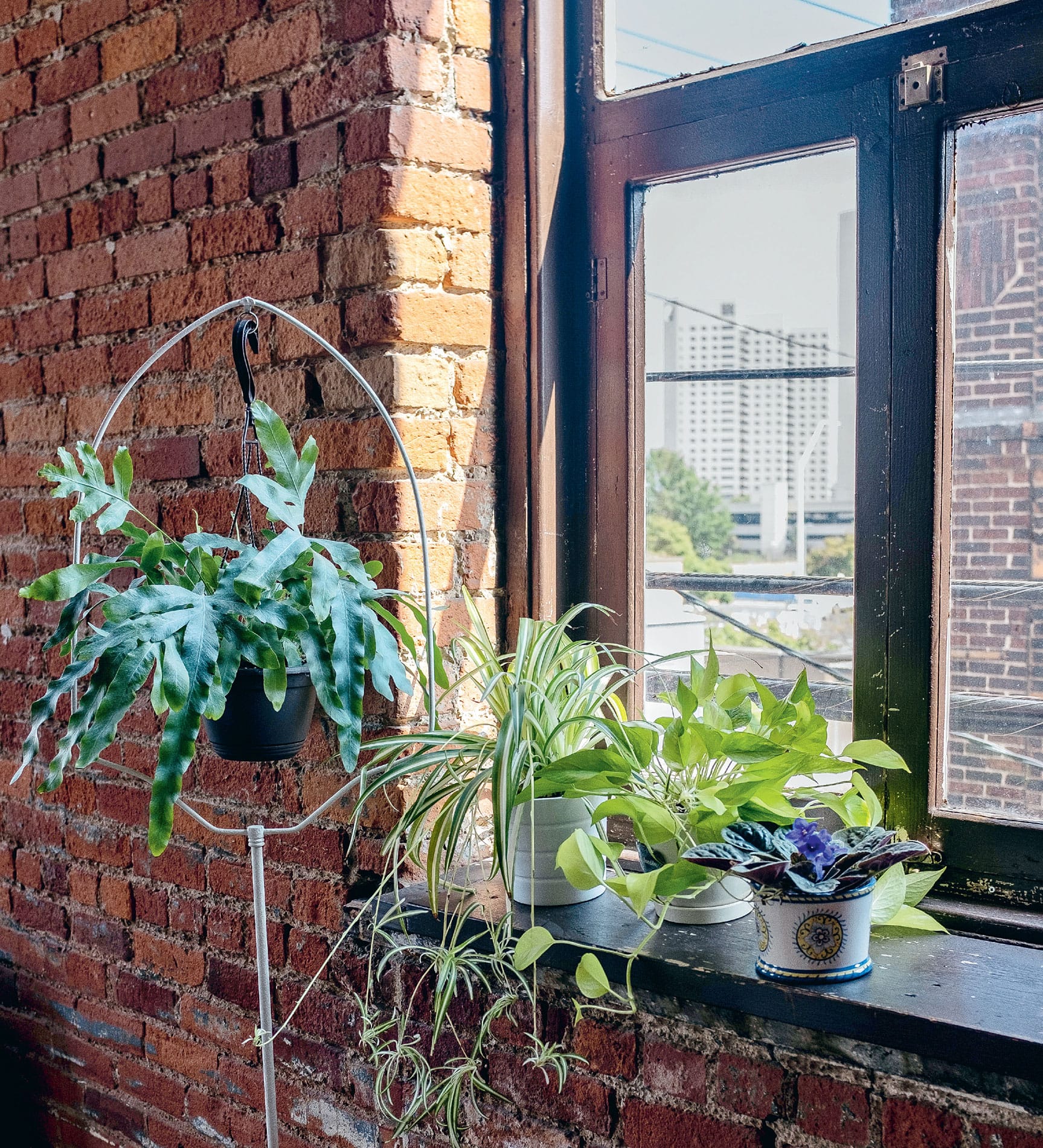
An east exposure receives the soft morning light. Ferns, spider plants, pothos, African violets, and begonias grow well in this exposure.
South
South-facing windows receive the most light throughout the day—it is an intense light that cacti and most other succulents appreciate. In the summer months, the sun is high in the sky, and the sunlight shines directly down into the window, so it doesn’t reach far into the room at all. If you hang a sheer curtain or place your plants a few feet back from a southern window, many lower-light plants will thrive in this exposure. If, on the other hand, a low-light plant is placed too close to a south-facing window without protection, it may burn and, if left there, die. The sun is lower in the sky in the winter, so at that time, the light from the sun comes in at an angle. The light from east and west exposures does not change as much in the winter as it does from the south. Low- to medium-light plants may actually do better in a south window in the winter months.
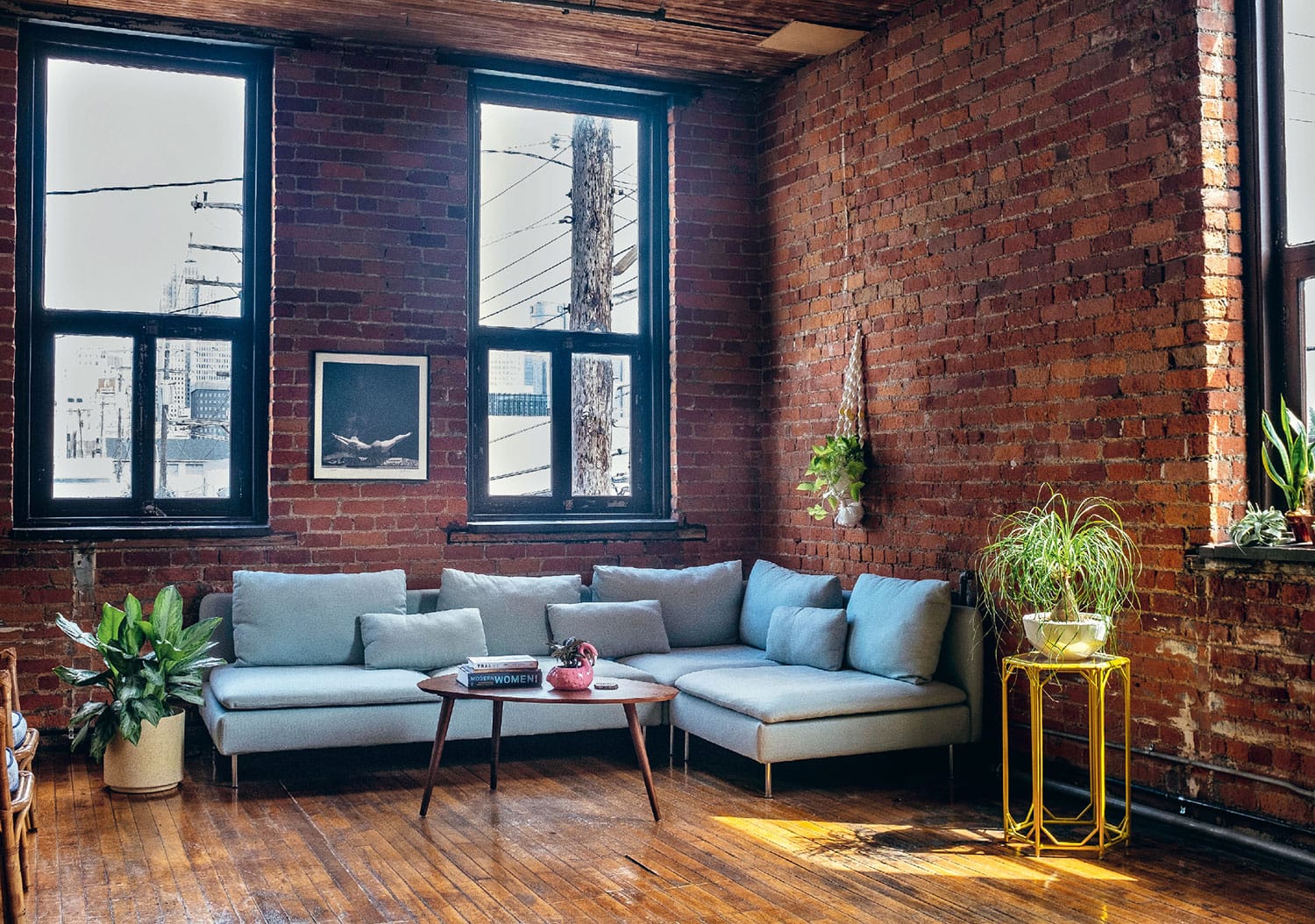
A west exposure can support cacti and other succulents, as well as air plants. Because the sun sets on an angle, low-light plants, such as aglaonema, can survive further back in the room. If you have a southern or high-light window but would prefer to grow low-light plants, a sheer curtain or blind can cut down the light to an acceptable level to make low-light plants happy.
North
North windows never receive any direct sunlight. The plants they can support generally are only foliage plants, such as the cast-iron plant (aspidistra), philodendron varieties, the ZZ plant, and pothos. These plants naturally grow on the rainforest floor, where they live in the shade with only dappled light to sustain them. Flowering plants are usually not an option for northern exposures unless some sort of electric light is added to supplement the sunlight (see here). If you have a table lamp regularly turned on in the evening, the small amount of extra light may allow you to grow a higher-light plant than would normally grow in a north exposure, and you may even get an African violet or other flowering plant to bloom.
The Fifth Exposure
Skylights are considered a fifth exposure. They bring extra light into the room directly from above, moving across the room with the sun, and may allow you to grow a greater variety of plants. Be aware, though, that wherever the skylight shines, the light will be an intense light. Though it might not be on your plant for a long amount of time, it may burn low-light plants.
Garden-Level Apartments
If you live in a garden-level apartment, you may receive less light than the apartments above you. All is not lost. If your windows are placed high in your wall, near the ceiling, hanging plants are a good choice. You can also hang a shelf below the window to act as a deep windowsill on which to place your plants, giving you the additional benefit of some extra privacy without having to shut the blinds during the day. Purchase a tree-form houseplant, such as a tall dracaena, whose leaves reach window height. If some amount of light is getting into your apartment, there should be a plant that will survive there. Adding some small grow lights to supplement your light would be helpful too.
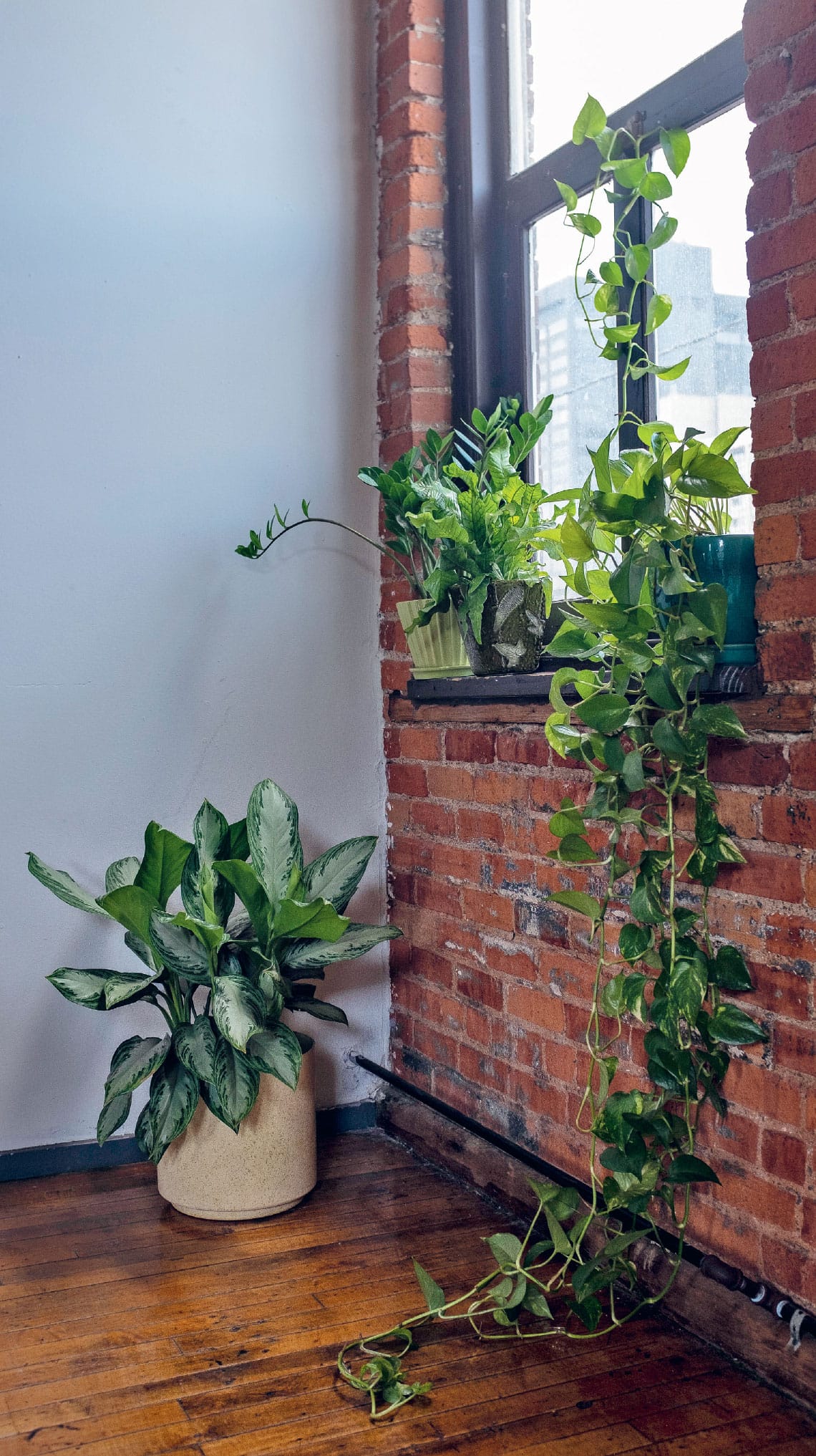
Many plants do well in the low light of a north window. From left to right: ZZ plant, crocodile fern, pothos, and an aglaonema on the floor.
Light Factors
You may be excited to discover that you have a southern-exposure window, yet the light coming in isn’t as bright as you hoped and the high-light cactus that should be doing well is struggling. Have you noticed the large overhang extending over your window? How about the awnings that were put up to block the light from fading the carpeting or drapes? What about that enormous tree right outside the window? All these factors determine the amount of light that comes through a window. If you have a deciduous tree right outside—one that drops its leaves in the fall—you will, in fact, have more light in the winter months than you do in the summer. If it is an evergreen, like a Christmas tree, you will have shade the entire year. And what about that huge building next door, blocking all your sun? If it is painted a dark color, it will absorb light; if it’s a light color, it will reflect some of the light into your windows. All these factors determine the amount of light coming into your room and the amount falling on your plants’ leaves. Read about some creative ways to bring more light into your home shown here.
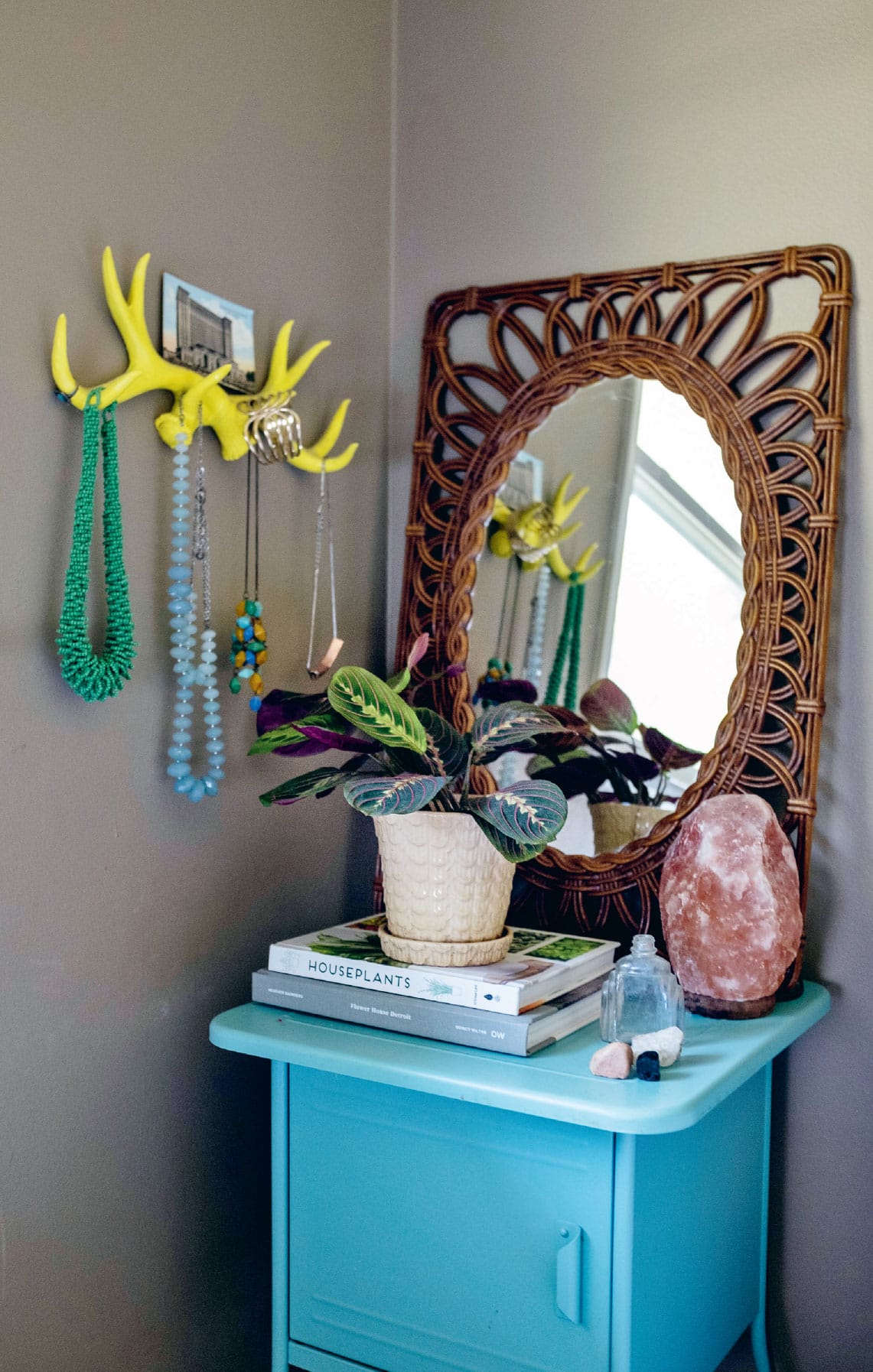
This prayer plant is in a low-light area not directly in front of a window. The mirror reflects the light from the nearby window onto the plant, giving it a bit more light.
Phototropism
If you find your plants are leaning toward the window, it is probable that your plant is suffering from phototropism. That may sound like a disease, but it isn’t. Sunlight only comes in from one direction in most windows, and, of course, your plant will grow toward the light. This problem can be fixed by simply turning your plants a quarter turn every time you water them. If you notice your plant is bending noticeably between waterings, it may need to be turned more often. If your plant is too large to turn often, place it on a saucer with wheels to make it easier to move. After turning the plant, it will usually straighten out, but if it is a plant with a woody stem, such as a ficus, it may have a small curve in the stem forever—thus, it is imperative to turn your plant often to prevent this.
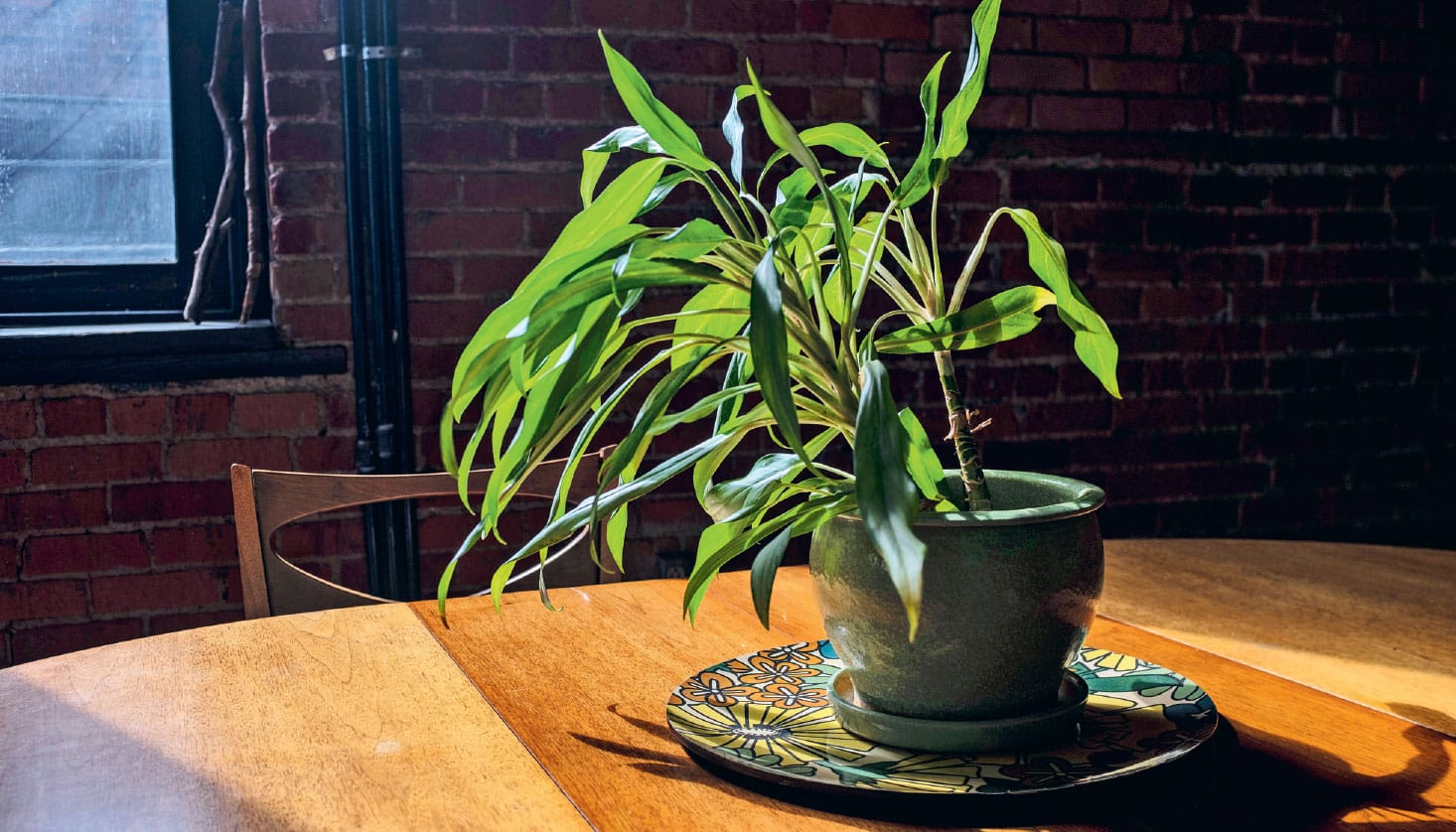
A plant that isn’t regularly turned will lean toward the light and grow lopsided. Give your plant a quarter turn every time you water, so it will grow symmetrically.
Plant Tags
When determining whether you have enough light for the plant you have chosen, check its container for a grower’s tag and take the time to read it. Many tags are generic and may label something simply as a tropical plant or a houseplant, which only tells you it won’t live outside in northern areas. On the other hand, a tag that identifies the specific plant, such as African violet or staghorn fern, will have more specific information pertaining to it. Try Googling the name on the tag if there is no identifying picture to be certain that the plant listed on the tag is in fact the plant you are purchasing; tags can become mixed up accidentally at the growing facility or garden center.
A plant tag may describe the light needed as high, bright, medium, indirect, part shade, and so on. What is the difference between these descriptors, and what do they all mean? In some cases, they are just different ways of saying the same thing. The chart below decodes some common light descriptors found on plant tags.
LIGHT TYPE |
WINDOW |
High, bright, direct, full sun |
South or west |
Medium, indirect, part shade, shade |
East; a few feet back from a south or west window |
Low light, part shade, shade |
North; a few feet back from an east or west window; many feet back from a south window |
If, after placing your plant in the light that the tag recommends, you find that your plant is not doing well, it may be that the light level isn’t right for the plant. How can you tell whether it is receiving too much or too little light? Read on.
Too Much or Too Little?
Our plants can suffer if they have too little or too much light. What are the indicators you should look for? Let’s talk about too little light first. The first indicator is phototropism, as we discussed shown here. The second sign is that the new growth will be pale with small leaves. In the case of cacti or other succulents, the plants may stretch toward the light and lose their shape. If you have a plant that should normally bloom, such as an African violet or orchid, and it hasn’t bloomed within a year, it may not have sufficient light. If you have a plant that collapses for no apparent reason, check the root system. It may be soggy and mushy because the plant didn’t have enough light for the roots to use all the water they were given. Plants use more water in higher light. More about that in the next chapter.
You might not have thought a plant could have too much light, but many plants prefer a medium to low light, and light that is too direct or focused on the plant for too much of the day will have adverse effects on them. If a plant gets excessive light or heat, it may wilt severely. If you see this, move the plant a few feet from the window; hopefully, it will recover. Sometimes plants will react to excessive light by curling their leaves down around the pot, trying to draw away from the light, like a vampire. If a plant has been in a low-light situation and is moved to high light, the result will be sunburned leaves. These leaves will not recover and return to their former color or fade to a nice tan, and the growth may be compact and stunted from too much light.
Both too little and too much light can result in the death of a plant if the situation isn’t rectified in a timely manner. Pay attention to your plants, and with close observation you’ll be able to understand what they are trying to tell you.
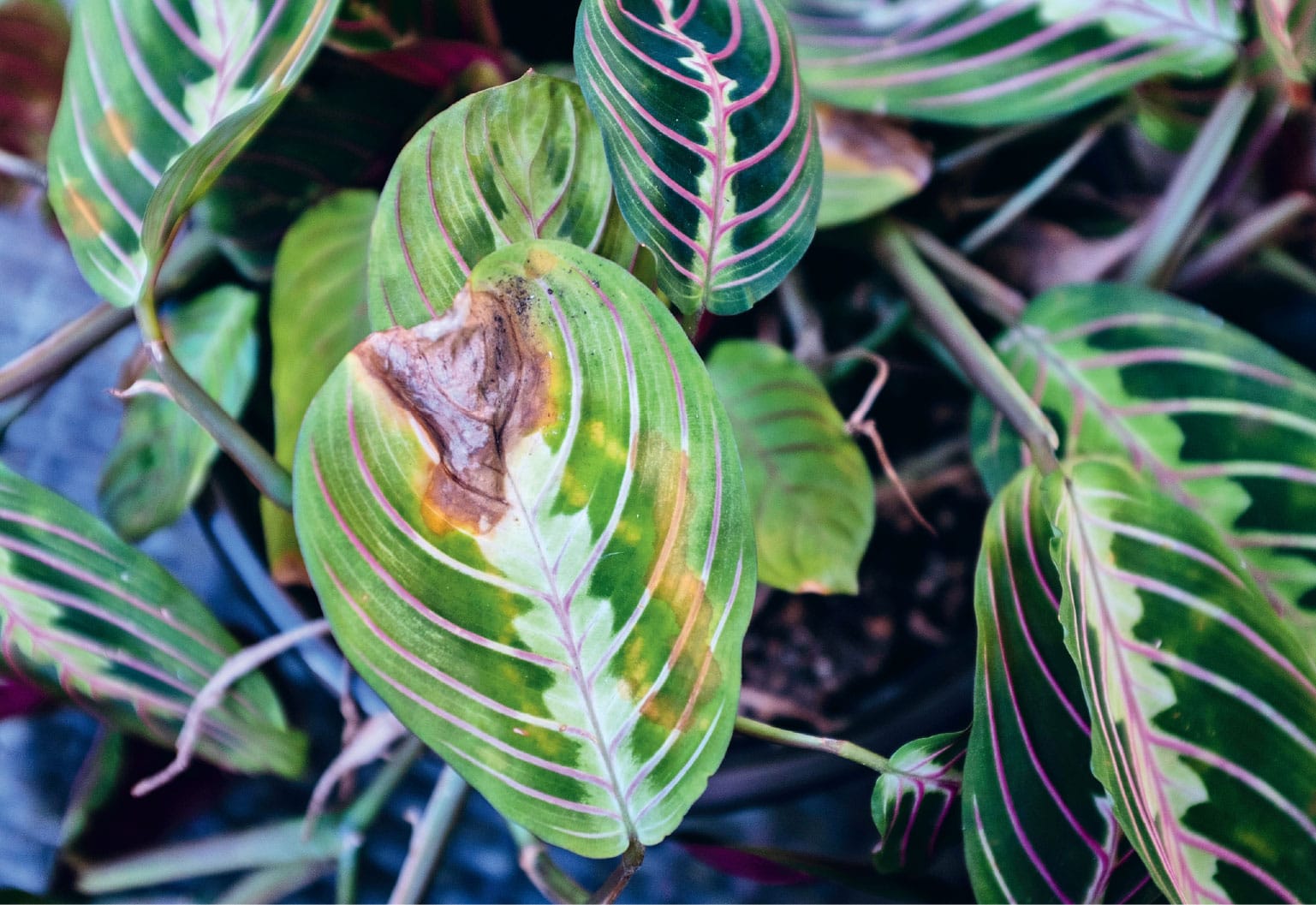
This low-light plant has been placed outside in too much sun, and as a result the leaves are burnt. If you’re moving outdoor plants inside, do so slowly, by first placing them in the shade. Most low-light plants would prefer not to be placed in the full sun outside.
ELECTRIC LIGHTS
If you find you do not have enough sunlight to sustain the plants you want to grow, you always have the choice to add supplemental light in the form of electric lights.
EVEN IF YOU LIVE in a room without any windows, or without those that let in enough light to grow plants, you can grow numerous plants with electric lights. There are many options, ranging from small and simple devices to larger hanging lights that blend in better with your décor.
Fluorescent light is the most common type of light people use to supplement their plants. There are different types of fluorescent lights to choose from, including T-5, T-8, and T-12 bulbs, the latter being the oldest variety and the most inefficient type. Many growers use T-5s or T-8s because they are more energy efficient.
I installed simple, inexpensive, 18-inch-long fluorescent plant lights under my cupboards so that I can have African violets blooming almost constantly on my countertop, right next to the coffee maker. It doesn’t get much better than that. Many African violet growers use lights to ensure their plants are growing symmetrically and blooming almost constantly; cacti and succulent growers use them to ensure their plants do not etiolate, thus ruining the natural growth pattern of the species they are growing. It’s common for people to grow plants exclusively under lights to give the plants the exact light levels and habitat they need to grow to their fullest potential.
LED lights are the newest lighting method used for plants; they are much more energy-efficient than fluorescent lights. While these lighting fixtures are relatively expensive compared to fluorescent lights, they do last much longer and use less energy, as they do not have to be on as long to affect your plants. Many newer kitchens have LED lights installed under the cupboards as part of the design, and there are grow lights that can clip on to any shelf or even your computer screen to allow you to grow plants essentially anywhere you want them.
Incandescent bulbs are too hot and do not supply the complete light spectrum a plant needs to grow properly. Yet, if a lamp is left on near a plant during the evening hours, the extra light provided will still help your plant grow better.
It adds interest in the evening to up-light a plant with a spotlight on the floor, casting cool shadows on the ceiling, but that really doesn’t help your plant grow. The chlorophyll, where the energy is manufactured, resides on the upper surface of the leaves. Lighting a plant from above, on the other hand, will assist it in photosynthesis.
In this book, we will be mainly discussing the plants that can be grown with a modicum of light. If you have that amazing southern sun streaming in and are growing cacti and other succulents successfully, you may think you do not need this book. But if you want to grow plants on your coffee table across the room, this book will help you choose the plants that will be able to thrive in a lower-light situation.
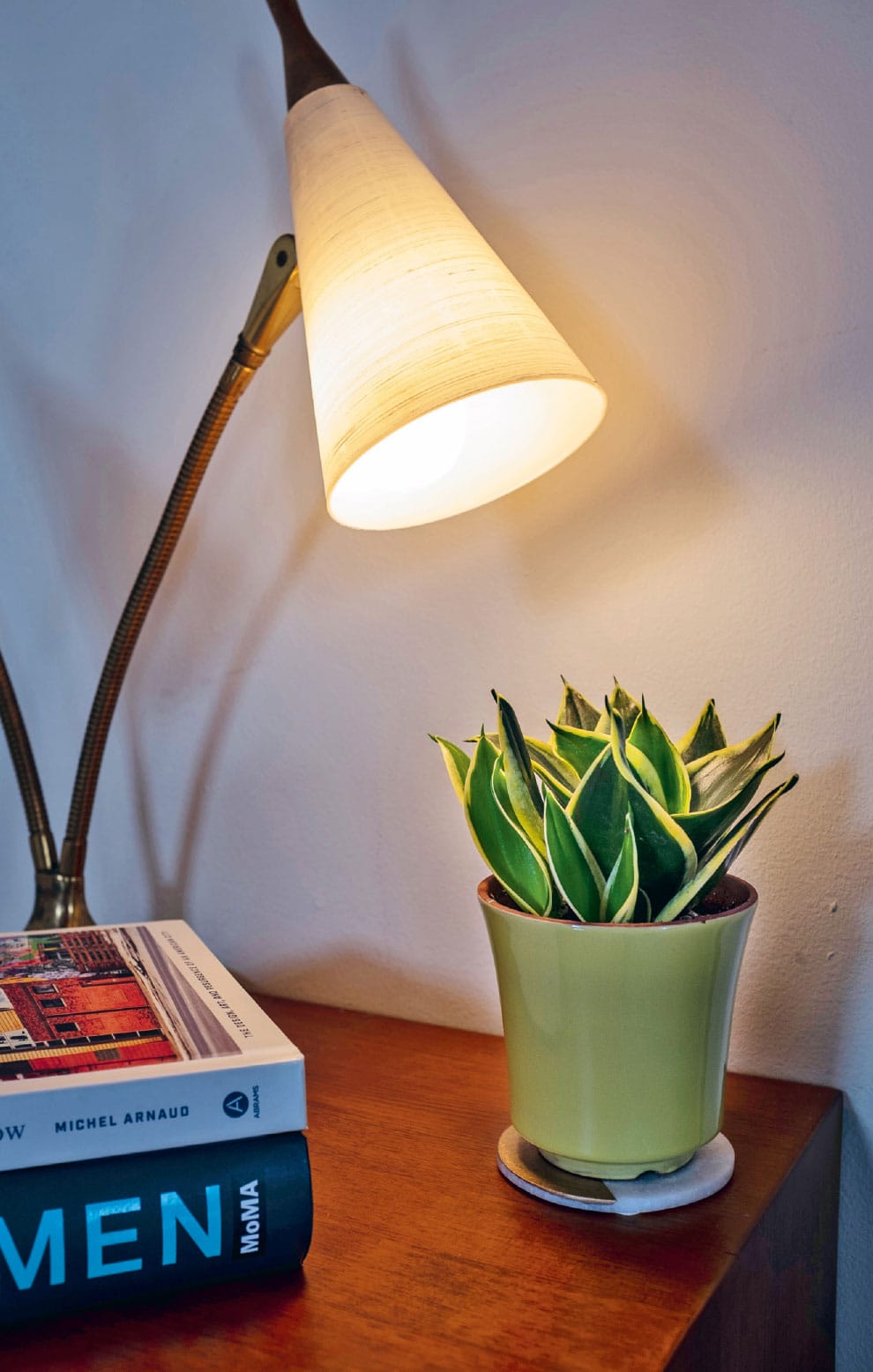
Don’t discount the light coming from an ordinary table lamp in the evening hours. It can give your plant the little extra boost it may need to thrive.
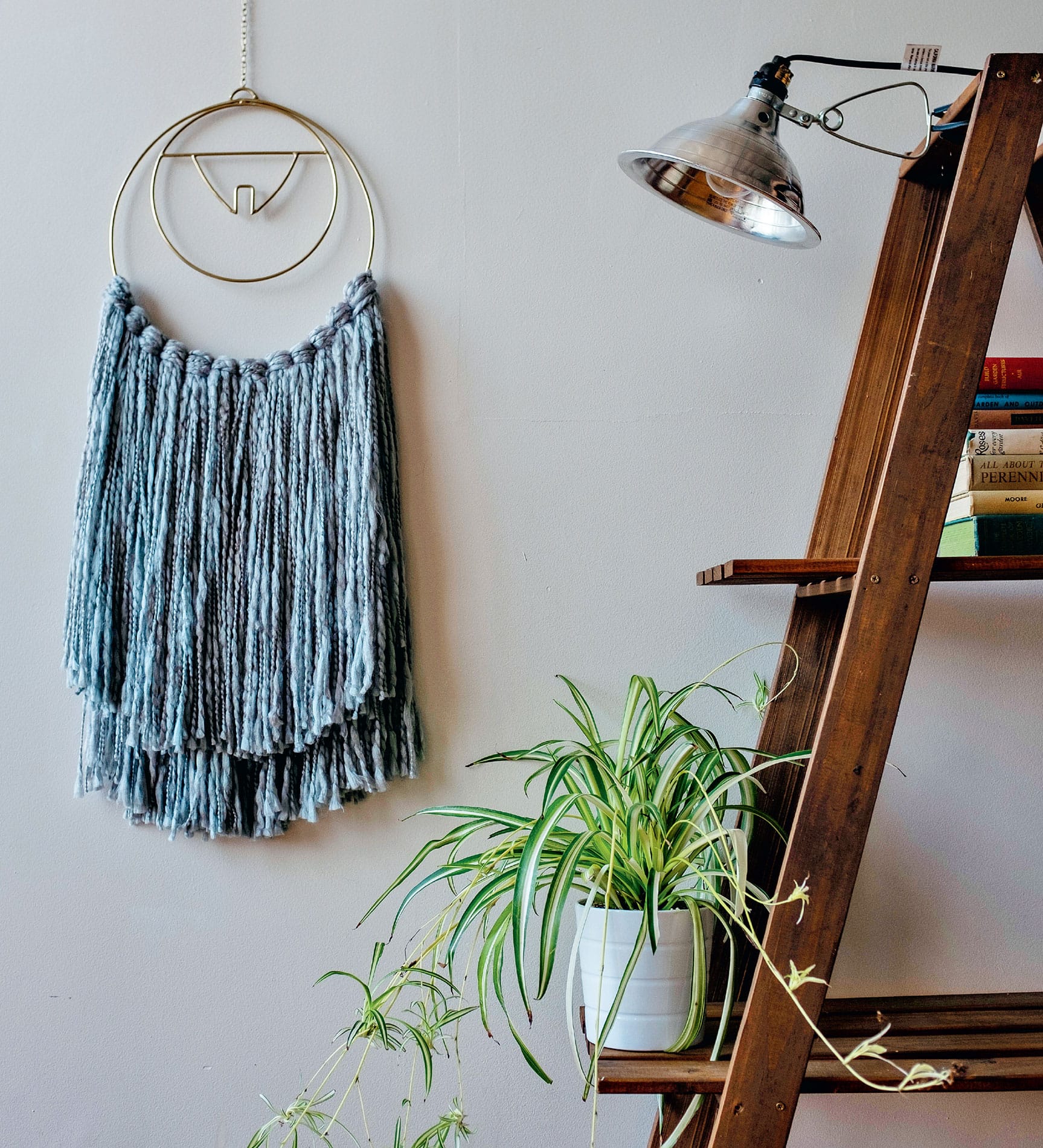
If you have a low-light spot where you would like a plant, try using a lamp with a specialized grow light. Inexpensive grow light setups can be made with simple grow bulbs and a basic workshop clamp light.